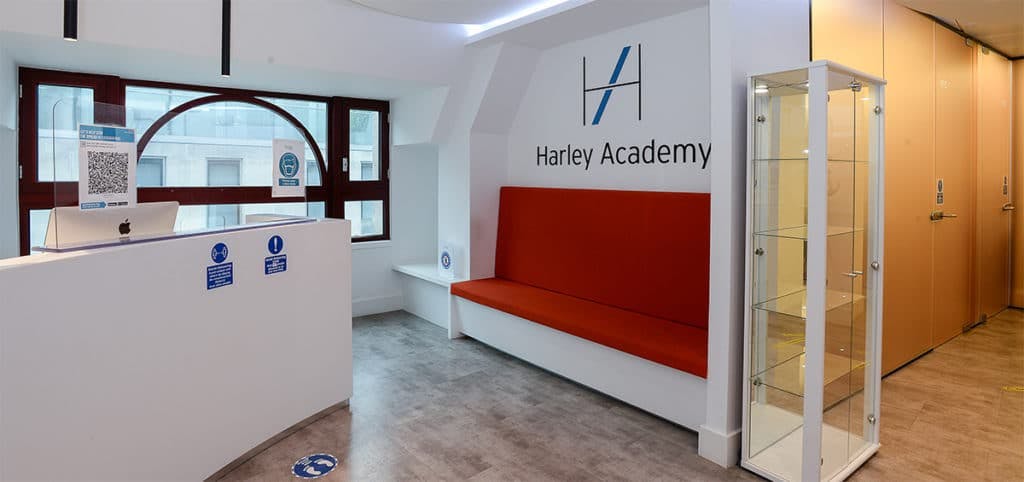Reception’s Role In Patient Care

Providing outstanding patient care starts before they ever step foot in your practice. Even if you’re a solo practitioner, never underestimate the value of outstanding clinic reception skills.
This is a critical part of the patient experience; offering fantastic care here will help you to retain clients and attract new ones through recommendations.
A patient’s journey starts when they reach out to enquire about your services or book an appointment. From there, every touchpoint is an opportunity to mark yourself out as their aesthetics professional of choice.
Whether you have a clinic with its own reception, have a shared reception, or if you’re a one-man band covering everything, reception skills are important.
The Academy Clinic – Harley Academy’s busy training clinic – has an outstanding reception team, managed by Lydia Vincent. Frequently mentioned warmly in patient feedback, they are the face – and voice – of our patient-facing operations.

Creating the best clinic reception experience for patients
As our award-winning clinic manager, Lydia ensures The Academy Clinic’s smooth day-to-day running. Additionally, she’s responsible for creating and maintaining a welcoming environment and fantastic patient experience.
We spoke to her to find out more about the role a clinic reception plays in the overall patient experience. She also gave us her advice on dealing with common complaints from aesthetics patients. Read on so you can learn from her insights…
What role does a clinic reception play in the overall patient experience?
“It’s always good to remember that a lot of the time the reception team is the first point of contact for your patients,” explains Lydia. “So it’s important they’re informative and friendly as it may be the difference between the patient booking in or not!”
“Creating a clean, professional but calming reception area, as well as a great clinical environment with cohesive branding, all contributes to a positive patient experience.”

Lydia’s top five tips for creating a welcoming clinic reception are…
- Always have a member of the reception team (or yourself, if you’re a solo practitioner) present in the front of house area when a client enters.
- Be warm and friendly in all your communications; this may be a daunting experience for some patients so it’s important to put them at ease. Smiling before you answer the phone can really help here; it automatically helps you to come across as more approachable and friendly which is especially important when dealing with potentially nervous patients.
- Ensure anyone dealing with patients directly – whether in person, on the phone, via email or on social media – communicates clearly in each scenario. Some people may be able to explain themselves clearly in writing but not in person, and vice versa. It’s crucial you and your team are able to communicate well via all channels if you want to provide the best possible service.
- Have easy-to-read, top line information available – such as your treatment menus – in the waiting area.
- This should go without saying but ensure the area remains clean and free of clutter. This includes, for example, keeping the floors clean when it’s raining and patients are walking dirty water in from the street. A quick, discreet mop can work wonders!

What about solo practitioners or injectors who share a reception?
“If you have a shared reception, don’t be afraid to talk to the team about their normal routine,” Lydia suggests. “Learn what works for them and, where necessary, provide them with details of how you’d like your patients to be treated.”
“For solo aesthetics practitioners, if you’re both the injector and the reception team this can be both a challenge and a great opportunity,” she assures us.
“Obviously you’ll need to spend more time addressing the patient’s needs from their very first enquiry. This means getting them booked in, consulted, treated, providing any aftercare, answering questions and taking payment, and dealing with anything else that may arise. It’s a lot, but look at all the opportunities this pipeline offers for building a meaningful relationship. Creating a rapport is easier when you deal with people more often, so – especially at the start of your career – this can be a great way to build a loyal client base who will (hopefully!) stay with you for years to come.”
What does reception take care of and how does it feed into patient care?
Lydia notes, “Typical patient-facing reception duties include ensuring initial patient queries are answered in a timely manner and booking people in for the correct appointments. Making payments and bookings needs to be quick and easy. People appreciate you making their journey as efficient as possible, without compromising on friendliness.”
“Making sure patients have all the aftercare information they need and that any follow-ups are in place without them having to ask, also help to give that 5-star client journey”.
“It’s not just about booking them in, welcoming them when they arrive and taking payment once they’re done though,” she counsels. “There are lots of little touches you can introduce to really personalise and upgrade the whole experience.”
“For example, making a note on their file of their favourite drink so you can ‘remember’ it each time they visit. Attention to detail is everything when it comes to great patient care. I recently introduced regularly changing floral displays into our reception. This small change has drawn so many compliments from patients – and staff! – and adds a touch of luxury to their appointment.”

What are the most common complaints clinic receptions deal with and how do you address these?
“In my experience, there are two scenarios which crop up most regularly with regards to complaints,” says Lydia.
“Firstly, toxin patients contacting us to say they need a top up, or that their botox hasn’t worked. When we receive these calls we educate them about the fact that toxin is a prescription drug – a medical treatment administered by a medical professional. Each treatment can vary and results won’t always be the same. It’s always important to explain things clearly to patients and to reassure them. They will have been told all this during their initial consultation and treatment appointment. However, sometimes it just takes that extra bit of attention to truly put their mind at rest.”
“Secondly, a common issue is patients arriving too late to be treated. We do allow a certain amount of wiggle room when it comes to people being late. However, we run a busy clinic so outside of that margin, we have to be strict on when ‘late’ is too late. In these instances we always explain politely that we need to allow enough time to complete a thorough consultation, as well as sufficient time for the treatment itself,” explains Lydia.
“Some patients will accept this and rebook, others may not take the news so well. Try not to take any frustrations they express personally; you can still remain calm, friendly and professional but it’s important to maintain your position. It’s more often the case that, once you make an exception for a patient, they then believe this to be the rule. By holding firm from the beginning you’re not simply pushing the problem further down the line when it may be more difficult to deal with.”
“Also, you don’t want your patient to have a rushed experience. Nor do you want your injectors to be frantic, trying to fit everything into a shorter period than is reasonable. In this regard, you need to act as a gatekeeper of the clinic’s reputation to ensure everyone gets the best possible outcome.”
To find out more about providing a great patient experience, get exclusive tips from our interview with aesthetics business consultant, Vanessa Bird. Or, to learn about how to manage patient complaints as an injector, check out our advice.
All information correct at the time of publication
Download our full prospectus
Browse all our injectables, dermal fillers and cosmetic dermatology courses in one document
By submitting this form, you agree to receive marketing about our products, events, promotions and exclusive content. Consent is not a condition of purchase, and no purchase is necessary. Message frequency varies. View our Privacy Policy and Terms & Conditions
Attend our FREE open evening
If you're not sure which course is right for you, let us help
Join us online or in-person at our free open evening to learn more
Our Partners














STAY INFORMED
Sign up to receive industry news, careers advice, special offers and information on Harley Academy courses and services

